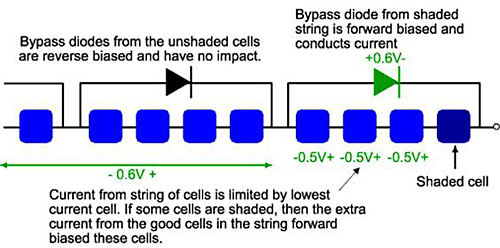Bypass diodes play a key role in solar modules
First, hot spot effect
A solar module that is shielded in a series branch will be used as a load to dissipate the energy generated by other solar modules. The shaded solar module will heat up at this time, which is the hot spot effect. This effect can severely damage solar cells. Some of the energy generated by a solar cell that is illuminated may be consumed by the obscured battery. In order to prevent the solar cell from being damaged due to the hot spot effect, it is preferable to connect a bypass diode in parallel between the positive and negative electrodes of the solar cell module so as to prevent the energy generated by the illumination device from being consumed by the shielded component.
Second, the role of Bypassdiode:
When the hot spot effect of the battery does not generate electricity, it acts as a bypass, allowing the current generated by other cells to flow out of the diode, so that the solar power system continues to generate power, and the power generation circuit will not be generated because of a problem with a certain cell. Happening.
Third, Bypassdiode selection principle:
1, pressure capacity is twice the maximum reverse operating voltage;
2, current capacity is twice the maximum reverse operating current;
3, junction temperature should be higher than the actual junction temperature;
4, small thermal resistance;
5, pressure drop is small;
Fourth, the actual junction temperature temperature measurement method:
Place the assembly in a 75-degree oven until thermal stability, pass the actual short-circuit current of the assembly in the diode, measure the surface temperature of the diode after thermal stabilization (for example, 1h), and calculate the actual junction temperature according to the following formula:
Tj=Tcase+R*U*I
R is the coefficient of thermal resistance, given by the diode manufacturer, Tcase is the surface temperature of the diode (measured with a thermocouple), U is the voltage drop across the diode (measured value), and I is the short-circuit current of the module. The calculated Tj cannot exceed the junction temperature range of the diode specification.
Fifth, the effect of bypass diode on the circuit diagram:

When the battery is working normally, the bypass diode is reversed and cut off, which will not have any effect on the circuit; if there is a non-working battery slice in the battery group connected in parallel with the bypass diode, the entire line current will be determined by the minimum current battery. The current size is determined by the area covered by the battery. If the reverse bias is higher than the minimum voltage of the battery, the bypass diode is turned on. At this time, the abnormally operating battery is short-circuited.
6. Calculation of the number of parallel-connected solar cells per bypass diode
1. The minimum current capacity of the bypass diode should be:
I=4.73×2=8.46A
2, choose 10SQ030 diode
The maximum back-bias voltage is: VRRM=30vIAV=10AVF=0.55V
TJ=-55-200°C
3. Bypass diodes with a withstand voltage of 30V can protect a maximum of 125 x 125 cell slices:
N=30/(2×0.513)≈29.24
That can protect up to 29 125 125 batteries;
4, there is a reverse current when the bypass diode is off, ie dark current, generally less than 0.2 microamperes;
In principle, a bypass diode should be connected in parallel with each cell in order to better protect and reduce the number of invalid cells under abnormal conditions, but due to the impact of the cost of the bypass diode and the dark current loss and the presence of voltage drop during operation. For silicon cells, a bypass diode can be connected in parallel for every fifteen cells.
The effect of shielding one cell is not the same as shielding two halves of two cells. Therefore, if the shadowing is unavoidable, try to shade as many cells as possible, with as few shadows as possible for each cell.
Tankagon Coupling,High Pressure Hose Clamps ,Rubber Pipe Coupling ,Air Hose Fittings Types
Plastic Tube, Pipe & Hose Co., Ltd. , http://www.hydraulic-couplings.com